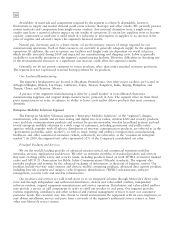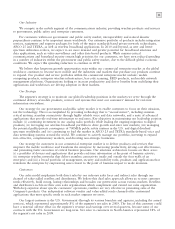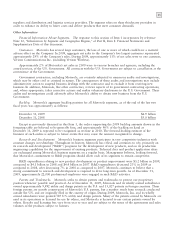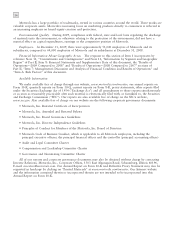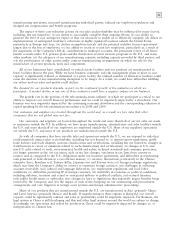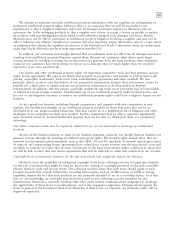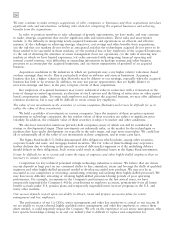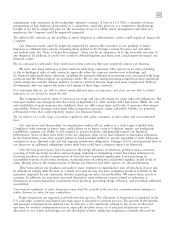Motorola 2009 Annual Report Download - page 28
Download and view the complete annual report
Please find page 28 of the 2009 Motorola annual report below. You can navigate through the pages in the report by either clicking on the pages listed below, or by using the keyword search tool below to find specific information within the annual report.
20
•Our ability to sell receivables could be impacted: The conditions placed on us by the parties that we sell
our receivables to may become more stringent. If we are unable, or choose not to, meet these new
conditions, our ability to sell the receivables will be negatively impacted. Although in 2009 Motorola made
a strategic decision to reduce accounts receivable sales and, therefore, has not been capacity constrained in
receivable sales, if the Company elects to return to historic levels of receivable sales its ability to do so may
be limited.
•Our access to short-term borrowing in the commercial paper market is very limited: While the Company
has not issued commercial paper since 2007 and does currently view the commercial paper markets as a
source of liquidity, if the Company needs access to very short-term borrowing, it may no longer be able to
access the unsecured commercial paper market because of its F-3/P-3 short-term ratings. Other sources of
short-term borrowing may be more limited, if available at all, and will have higher cost to borrow than
the commercial paper market.
The Company’s ability to borrow funds under its credit agreement could be constrained by the level of eligible
domestic receivables and inventory.
As amended in June 2009, availability under the Company’s existing domestic syndicated revolving credit
facility is the lesser of: (i) $1.5 billion, or (ii) an amount determined based on eligible domestic accounts
receivable and inventory. If the value of eligible accounts receivable and inventory were to decrease, the amount
available under the facility would decrease.
We operate in highly competitive markets and our financial results will be affected if we are not able to compete
effectively.
The markets for our products are highly competitive with respect to, among other factors: pricing, product
features, product and service quality, and the time required to introduce new products and services. We are
constantly exposed to the risk that our competitors may implement new technologies before we do, or may offer
lower prices, additional products or services or other incentives that we cannot or will not offer. We can give no
assurances that we will be able to compete successfully against existing or future competitors.
Our success depends in part on our timely introduction of new products and technologies and our results can be
impacted by the effectiveness of our significant investments in new products and technologies.
The markets for our products are characterized by rapidly changing technologies, frequent new product
introductions, short product life cycles and evolving industry standards. We face intense competition in these
markets from both established companies and new entrants. Product life cycles can be short and new products are
expensive to develop and bring to market. Our success depends, in substantial part, on the timely and successful
introduction of new products and upgrades of current products to comply with emerging industry standards and
to address competing technological and product developments carried out by our competitors. The research and
development of new, technologically-advanced products is a complex and uncertain process requiring high levels
of innovation and investment, as well as the accurate anticipation of technology and market trends. We may
focus our resources on technologies that do not become widely accepted or are not commercially viable. In
addition, our products may contain defects or errors that are detected only after deployment. If our products are
not competitive or do not work properly, our business will suffer.
Our results are subject to risks related to our significant investment in developing and introducing new
products, such as: advanced wireless handsets, including smartphones; WiMAX, LTE and other advanced
technologies for wireless broadband networks; products for transmission of telephony and high-speed data over
hybrid fiber coaxial cable systems; integrated digital radios; and integrated public safety systems. These risks
include: (i) difficulties and delays in the development, production, testing and marketing of products; (ii) customer
acceptance of products; (iii) the development of, approval of, and compliance with industry standards; (iv) the
significant amount of resources we must devote to the development of new technologies; and (v) the ability to
differentiate our products and compete with other companies in the same markets.
We have taken, and continue to take, cost-reduction actions. Our ability to complete these actions and the impact
of such actions on our business may be limited by a variety of factors. The cost-reduction actions, in turn, may
expose us to additional production risk and have a negative impact on our sales, profitability and ability to
attract and retain employees.
We have been reducing costs and simplifying our product portfolios in all of our businesses, with sizable
reductions in our Mobile Devices business. We have discontinued product lines, exited businesses, consolidated


